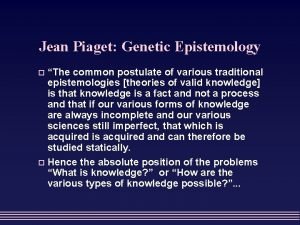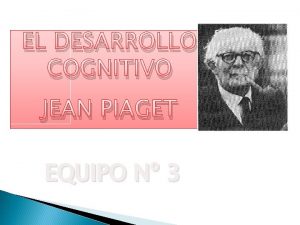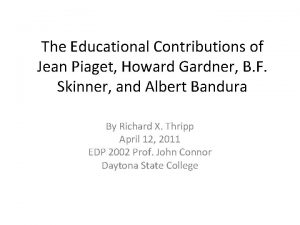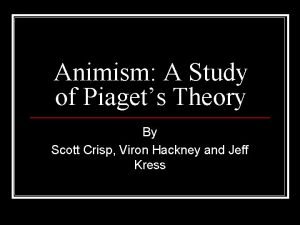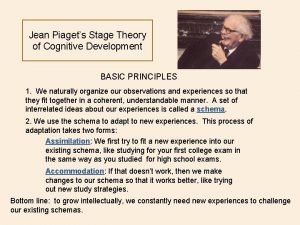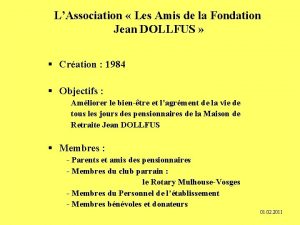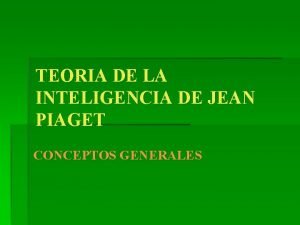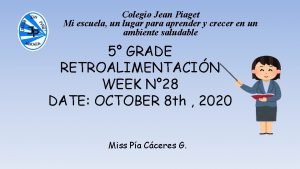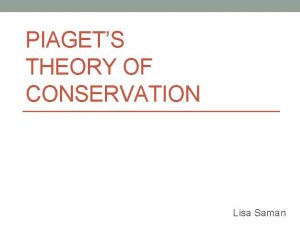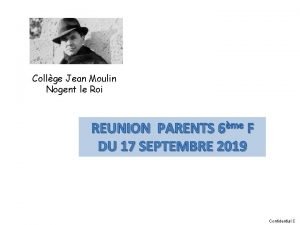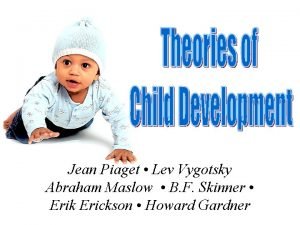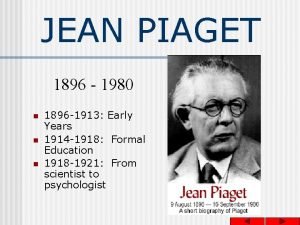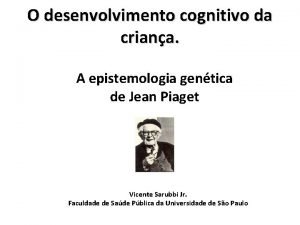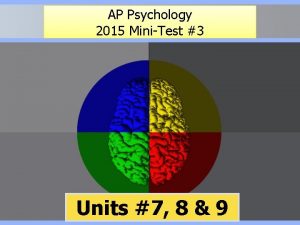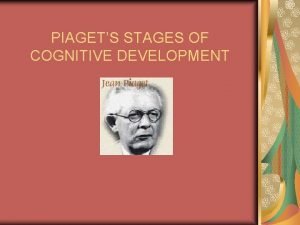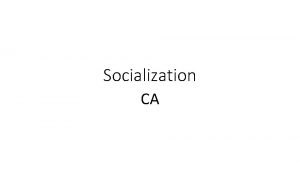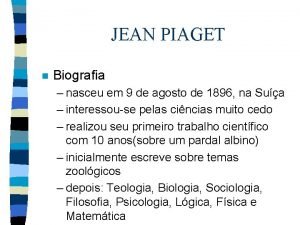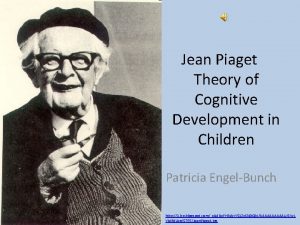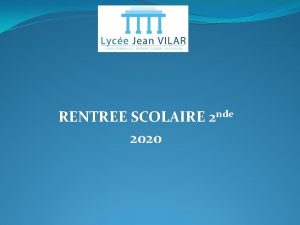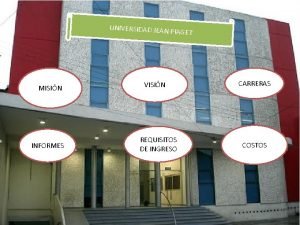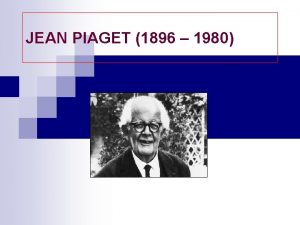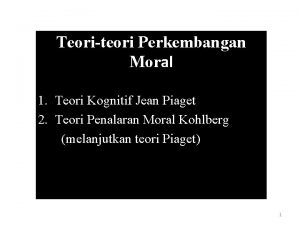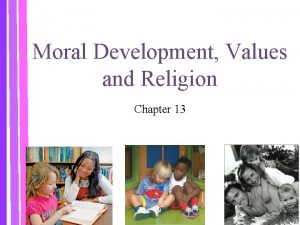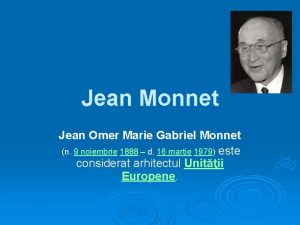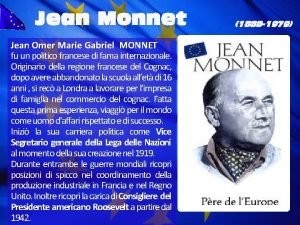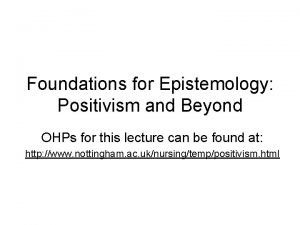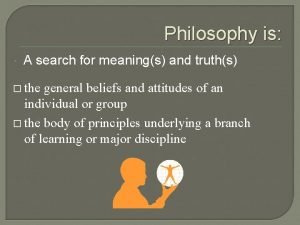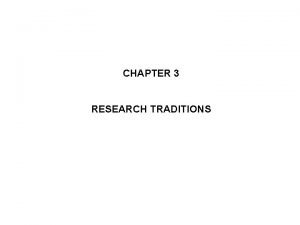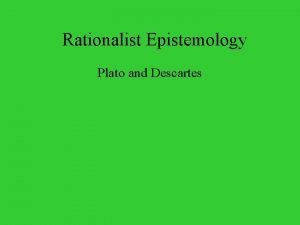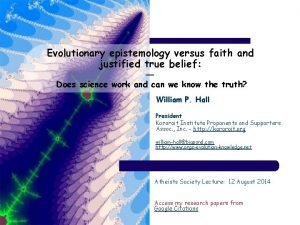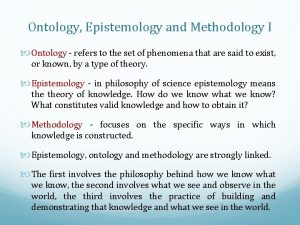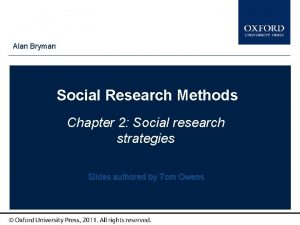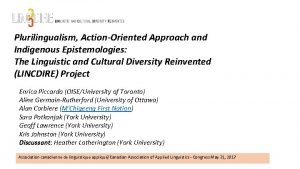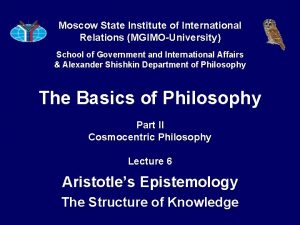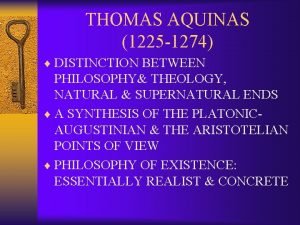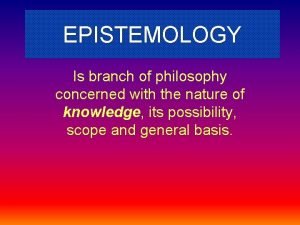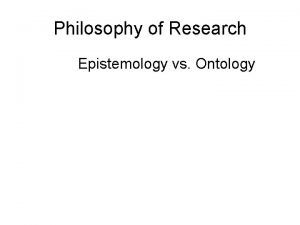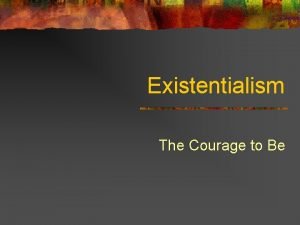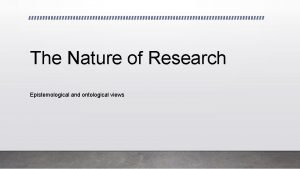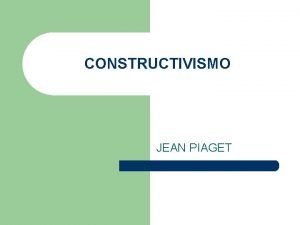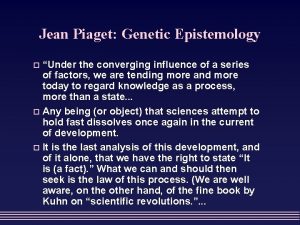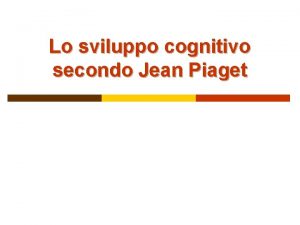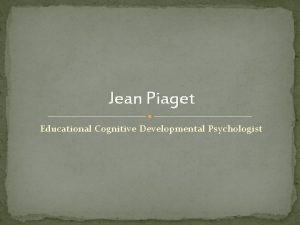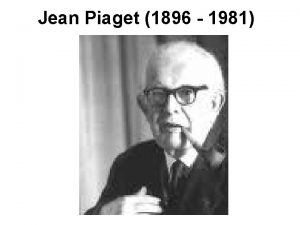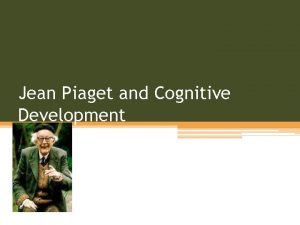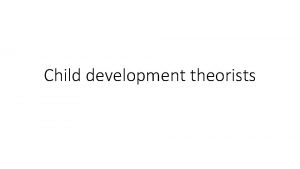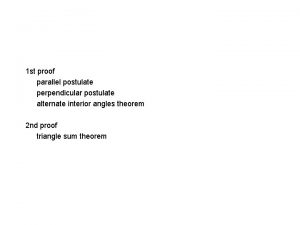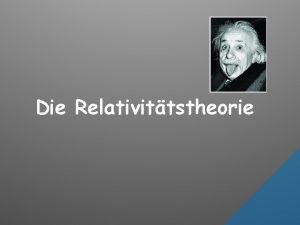Jean Piaget Genetic Epistemology The common postulate of








































































































- Slides: 104

Jean Piaget: Genetic Epistemology “The common postulate of various traditional epistemologies [theories of valid knowledge] is that knowledge is a fact and not a process and that if our various forms of knowledge are always incomplete and our various sciences still imperfect, that which is acquired and can therefore be studied statically. o Hence the absolute position of the problems “What is knowledge? ” or “How are the various types of knowledge possible? ”. . . o

“Under the converging influence of a series of factors, we are tending more and more today to regard knowledge as a process, more than a state. . . Any being (or object) that sciences attempt to hold fast dissolves once again in the current of development. o It is the last analysis of this development, and of it alone, that we have the right to state “It is (a fact). ” What we can and should then seek is the law of this process. (We are well aware, on the other hand, of the fine book by Kuhn on “scientific revolutions. ”. . . o

o In fact, if all knowledge is always in a state of development and consists in proceeding from one state to a more complete and efficient one, evidently it is a question of knowing this development and analyzing it with the greatest possible accuracy.

This beginning does not unfold itself as a matter of chance, but forms a development, and since the cognitive domain has an absolute beginning [and is a] development, this domain itself is to be studied at the very stages known as formation. . o The first aim of genetic epistemology is, therefore, if one can say so, to take psychology seriously and to furnish verifications to any question which each epistemology necessarily raises, yet replacing the generally unsatisfying speculative or implicit psychology with controllable analyses (on the scientific mode, therefore, of what is known as a control). ” o

Upon what does an individual base his judgements? o What are his norms? How is it that these norms are validated? o What is the interest of such norms for the philosophy of science in general? o (How does the fact that children think differently affect our presumption of fact itself? ) o

Problems Number and space o Time and speed o Permanent objects, identity, and conservation o Chance o Moral concerns o Play patterns and dreams o Imitation of others o

Constructivism: o “There is no structure apart from construction, either abstract or genetic” – cognitive or physiological o “Knowledge does not begin in the I, and it does not begin in the object; it begins in the interactions. . There is a reciprocal and simultaneous construction of the subject on the one hand, and the object on the other. ”

Developmental course o The stage theory: equilibration – adaptation: assimilation and accomodation (Kuhn): TRANSFORMATION – “Whereas other animals cannot alter themselves except by changing their species, man can transform himself by transforming the world and can structure himself by constructing structures; and these structures are his own, for they are not eternally predestined either from within or from without. ” – “The organism adapts itself by materially constructing new forms to fit them into those of the universe, whereas intelligence extends this creation by constructing mental structures which can be applied to those of the environment. ”

o The notion of the developmental stage – Constant orderly acquisition of behaviors – Integration of such behaviors across succeeding levels n n with proviso that this integration completes earlier development, and sets the stage for further with proviso that integration appears total

Motive for development: disequilibria o What is done does not produce the intended (desired) end.


Capacity for development: analogy to LOGOS Heraclitus and the “permanency” of the river, despite its movement o The Christian Logos -- the Word -- and the creation of the world o decentration: out of one scheme, into the domain of scheme construction (chaos) o – goodbye lovely rut (centration)

1. 0. Infancy Birth to age two o The undifferentiated experience o – Egocentricity without ego

1. 1. Sensorimotor Period Practical intelligence without “thought” o Action schemata (for mouth, eyes, hand, feet) o New objects are explored with action schemata o – estalishment of percepts

1. 2. Reflex action (first half of first year) Behavior limited to sucking, and then head turning o Behaviors are practiced and generalized o Child imitates own reflexes, and brings them under control: the circular reaction: the cybernetic loop (the feedback loop) o The mind begins its development by interiorizing the (observable) structures of the body. o

“Each object is assimilated as something “to be sucked, ” “to be grasped, ” “to be shaken, ” etc. , and is at first that and nothing more (and if it is “to be looked at” it is still being assimilated to the various focusings and movements of the eyes and acquires the “shapes” which perceptive assimilation gives it). .

it is by repeating his behaviors through reproductive assimilation that the child assimilates objects to actions, and that these become schemas. These schemas constitute the functional equivalent of concepts and of the logical relationships of later development. ” o Piaget, Explanation of Play, Dreams and Imitation.

1. 2. 1. The scheme o “What there is in common among several different and analogous actions. ” – distance: the fact of distance remains constant across situations – shared schemes serve as the referents for language n “A structure would lose all truth value if it did not have this connection with the physical facts. ” – as opposed to the concept: which appears as a declarative representation

We first act, and then form an image of what needs doing. o “. . . the whole process of development, starting out with perception and culminating in intelligence, demonstrates clearly that transformations continually increase in importance, as opposed to the original predominance of static perceptual forms. ” – perception: knowledge of an object from direct contact with it. – intelligence uses the mental image: the imitative schemata (representation) – the concept is an abstracted image (semantic representation of an episodic representation) – the Freudian “symbol” is mere use of earlier schemata

1. 3. Imitation (second half of first year) o Assimilation of the motor schemata of the observed other: prehension

1. 4. Sensorimotor intelligence includes Sense of distribution of surrounding space o Perception of objects within that space o Notion of causality as relationship between appearances, mediated by action o Beginning of time o

1. 5. “Object permanence” - end of second year. o o o “Another example of an unforeseeable encounter between the recent history of sciences and psychogenesis is furnished by the notion of object permanence. This permanence, which at the beginning of the century appeared evident and necessary, was, as we all know, questioned by contemporary microphysics, for which an object exists as an object (in opposition to its wave) only in so far as it is localizable. It can therefore be interesting to attempt to establish how the object notion has been formed, since it no longer appears enveloped in the same characteristic necessity its earlier history seemed to confer upon it. ”

2. 0. Early childhood: Two to seven years

2. 1. Socialization of Action Establishment of verbal communication o Facilitation of imitation thereby (the ego ideal) o Lack of self-awareness o No ability for discussion (collective monologue) o

2. 2. Genesis of Thought Preoperational thought: transition from sensorimotor intelligence to operational intelligence (abstraction) o Concrete operations: use of the thing, or the immediate imagination of the thing o Precausality: tendency towards anthropomorphization: Childhood animism o – The child does not think like the pre-empirical man; the pre-empirical man thinks like the child.

Children of this age are “practically unanimous in believing that the moon accompanies them on a walk, and their egocentricity impedes them from thinking what the moon would do in the presence of people strolling in the opposite direction. ” o The universe operates like the human being: things want to do things o

2. 3. Moral realism: attention to the letter of the law. o “. . . moral realism induces an objective conception of responsibility. . for since he takes rules literally and thinks of good only in terms of obedience, the child will at first evaluate acts not in accordance with the motive that has prompted them but in terms of their exact conformity with established rules. ”

“The combined effect of precausality, childhood animism, and moral realism on the psychology of the child is to present a world of intentional beings and objects, all focusing on the child, doing things for the child, and yet conforming to a set of rules that have no special justification but exist merely to be obeyed. ” o Rychlak, p. 694 o

2. 4. Intuition o The use of a sensorimotor schema as basis for abstract thought

“A child of four or five years may be shown a series of eight blue discs aligned in a row with little spaces between each, and be asked to reproduce the series by selecting red disks from a pile.

The child will intuitively construct an arrangement of red disks in a row of exactly the same length as the blue disks but without bothering to keep the number of disks identical, and without considering the matter of spacing between the disks. ” o Rychlak, p. 695

OOOO OOO OOOO O

The child can not yet think about the different ways (schemas) of analyzing and then duplicating the structure of the row. Furthermore, the row is analogous to a rod (a sensorimotor object).

2. 5. Semilogic: two brothers. One is asked do you have a brother? Does Paul (his brother) have a brother? [no] o egocentricity makes reversibility impossible

2. 6. Beginnings of self evaluation

2. 7. Necessity for environmental stability: o presuppositions must remain constant

3. 0. Late Childhood: Seven to Twelve

3. 1. Elimination of egocentricity development of self-model, equivalent to the other o more concentration on life tasks o more ability to collaborate (facilitate social construction) o

3. 2. Self-reflection emerges o “Reflection is nothing other than internal deliberation, that is to say, a dialogue which is conducted with oneself” – Relationship to Jung’s notion of personification of the dissociated personality elements

3. 3. Conservation emerges Two identical glasses, one taller narrower glass. o Two girls, Bridget (4) and Annette (7) o

Both are asked to place equal numbers of red beads in the first glass, and blue beads in the second. Red beads are then poured into the third glass.

When asked Which has more beads (second or third)? Bridget (4) says third; Annette (7) says neither. Annette (7) interrelates volume and shape schema; Bridget (4) relies on notion of height to define “more”.

Conservation is “possibility of rigorous return to the point of departure”

3. 4. Development of morality “since all men, including ‘primitive men, ” started by being children, childhood thinking preceded the thought of our own ancestors, just as it does our own!” o Piaget differentiates "morality of constraint" from "morality of cooperation, " describing morality as a "system of rules” that affective life makes use of to control behavior: o

". . . moral realism induces an objective concept of responsibility. . For since he takes rules literally and things of good only in terms of obedience, the child will at first evaluate acts not in accordance with the motive that has prompted them but in terms of their exact conformity with established rules. "

He associates morality of constraint with an earlier level of cognitive development; a level that nonetheless serves as a necessary precondition for further development. Piaget states: o "For very young children, a rule is a sacred reality because it is traditional; for the older ones it depends upon mutual agreement. "

"From the point of view of the practice or application of rules four successive stages can be distinguished.

A first stage of a purely motor and individual character, during which the child handles the marbles at the dictation of his desires and motor habits. This leads to the formation of more or less ritualized schemas, but since play is still purely individual, one can only talk of motor rules and not of truly collective rules.

The second may be called egocentric for the following reasons. This stage begins at the moment when the child receives from outside the example of codified rules, that is to say, some time between the ages of two and five. But though the child imitates this example, he continues to play either by himself without bothering to find play-fellows, or with others, but without trying to win, and therefore without attempting to unify the different ways of playing.

In other words, children of this stage, even when they are playing together, play each one "on his own" (everyone can win at once) and without regard for any codification of rules. This dual character, combining imitation of others with a purely individual use of the examples received, we have designated by the term Egocentrism.

A third stage appears between 7 and 8, which we shall call the stage of incipient cooperation. Each player now tries to win, and all, therefore, begin to concern themselves with the question of mutual control and of unification of the rules. But while a certain agreement may be reached in the course of one game, ideas about the rules in general are still rather vague.

In other words, children of 7 -8, who belong to the same class at school and are therefore constantly playing with each other, give, when they are questioned separately, disparate and often entirely contradictory accounts of the rules observed in playing marbles.

Finally, between the years of 11 and 12, appears a fourth stage, which is that of the codification of rules. Not only is every detail of procedure in the game fixed, but the actual code of rules to be observed is known to the whole society.

There is remarkable concordance in the information given by children of 10 -12 belonging to the same class at school, when they are questioned on the rules of the game and their possible variations. .

If, now, we turn to the consciousness of rules we shall find a progression that is even more elusive in detail, but no less clearly marked if taken on a big scale. We may express this by saying that the progression runs through three stages, of which the second begins during the egocentric stage and ends towards the middle of the stage of cooperation (9 -10), and of which the third covers the remainder of this cooperating stage and the whole of the stage marked by the codification of rules.

During the first stage rules are not yet coercive in character, either because they are purely motor, or else (at the beginning of the egocentric stage) because they are received, as it were, unconsciously, and as interesting examples rather than as obligatory realities.

During the second stage (apogee of egocentric and first half of cooperating stage) rules are regarded as sacred and untouchable, emanating from adults and lasting forever. Every suggested alteration strikes the child as a transgression.

o “The megalithic constructions of western and northern Europe have fascinated investigators for over a century. Indeed, it is impossible to look at a good photograph of the alignments at Carnac or the gigantic trilithons of Stonehenge without wondering what their purpose and meaning could have been. – Ca 2000 BC and earlier

o o o The technological ability of these farmers of the Age of Polished Stone arouses astonishment. How did they manage to set 300 ton blocks in an upright position, and lift 100 ton slabs? Then, too, such monuments are not isolated. They form part of a whole megalithic complex, which extends from the Mediterranean coast of Spain, covers Portugal, half of France, the western seaboard of England, and continues into Ireland, Denmark, and the southern coast of Sweden… All this undoubtedly testifies to a very important cult of the dead. Whereas the houses of the Neolithic peasants who raised these monuments were modest and ephemeral… the dwellings for the dead were made of stone. – Eliade, A history of religious ideas volume 1, pp. 114 -115.

Finally, during the third stage, a rule is looked upon as a law due to mutual consent, which you must respect if you want to be loyal but which it is permissible to alter on the condition of enlisting general opinion on your side.

The correlation between the three stages in the development of the consciousness of rules and the four stages relating to their practical observance is of course only a statistical correlation and therefore very crude.

But broadly speaking the relation seems to us indisputable. The collective rule is at first something external to the individual and consequently sacred to him; then, as he gradually makes it his own, it comes to that extent to be felt as the free product of mutual agreement and an autonomous conscience.

And with regard to practical use, it is only natural that a mystical respect for laws should be accompanied by a rudimentary knowledge and application of their contents, while a rational and well-founded respect is accompanied by an effective application of each rule in detail. ” o Piaget, J. (1932). The Moral Judgment of the Child. London: Kegan Paul, Trench, Trubner and Company Ltd. pp. 16 -18.

The second-stage child, who accepts the presuppositions of his cultural subtradition as "sacred and untouchable", thinks in the same manner as the classic pre-empirical or "primitive" man, who worships the past, in representation, as absolute truth.

The child and the primitive are both concerned primarily with how to behave -- with how to organize behavior, contra nature, in the social community, to simultaneously and continuously meet desirable ends. It is only much later, after these most fundamental of issues have been resolved, that the means of resolution themselves can be questioned.

This act of higher-order conceptualization means emergence of ability to play games, with the rules of games -- and belief in the justifiability of such activity (this rebuff to traditional order).

This more abstract ability allows for answer to the meta-problem of morality: not "how to behave? " but -how can (or is or was) how to behave be determined? "

Paradoxically, perhaps, the answer to this meta-problem also provides the final answer to the (apparently) less abstract question "how to behave? " or "what is the good? "

Some examples from western religious tradition may aid in comprehending (1) the distinction between the central problem ("what is the good (? )") and meta-problem ("how are answers to the question ‘what is the good? ’ determined? ") of morality, and their attendant resolutions

and (2) the manner in which the metaproblem and its solution follow in the course of historical development from the problem, and its solution -- attended by (cyclical) development of increasingly sophisticated and powerful consciousness.

3. 5. Sociohistorical echoes

The Ancient Israelites: Subjugation to tyranny o Escape into chaos o Formalization of tradition o – Journey to the Promised Land – Moses dies before he arrives, but is the only one to see it

o o o “The Biblical pattern for the purgatorial vision is the Exodus narrative, which is in three major parts. First is the sojourn in Egypt, the “furnace of iron, ” a world visited by plagues, where the Egyptian desire to exterminate the Hebrews goes into reverse with the slaughter of the Egyptian firstborn sons. This episode concludes with the crossing of the Red Sea, the separation of Israel from Egypt, and the drowning of the Egyptian host.

o o The second episode is the wandering in the wilderness, a labyrinthine period of lost direction, where one generation has to die off before a new one can enter the Promised Land (Psalm 95: 11). This is one of several features indicating that we are in a world transcending history, and that it is in the more poetic language of the prophets that the true or symbolic meaning of Egypt, wilderness and Promised Land emerges more clearly.

o The third stage is the entry into the Promised Land, where Moses, personifying the older generation, dies just outside it. In Christian typology. . . o this means that the law, which Moses symbolizes, cannot redeem mankind: only his successor Joshua, who bears the same name as Jesus, can invade and conquer Canaan. ”

o Frye continues: “And yet Canaan seems a rather shrunken and anticlimactic form of the paradisal land of promise flowing with milk and honey that was originally promised to Israel. Perhaps Moses was really the only person to see the Promised Land: perhaps the mountain outside it he climbed in his last hours was the only place from which it could be seen. n Frye, N. (1990). Words with Power: Being a Second Study of the Bible and Literature. New York: Viking Press, p. 299.

The state as “promised land” o Morality as Tradition – Custom – Habit – Procedure

The promised land as “ideal equilibration” o parts in harmonious relationship with whole – the whole tends to conserve itself – the parts tend to conserve themselves n the ideal equilibration occurs when the parts, conserving themselves, conserves the whole – and vice versa

The Ten Commandments: Morality as Rule o thou shalt not -- kill, steal, covet, undermine tradition , etc. – honour thy parents First order codification of tradition o Represented/felt as divinely ordained o

“Great men, like great epochs, are explosive material in whom tremendous energy has been accumulated; their prerequisite has always been, historically and physiologically, that a protracted assembling, accumulating, economizing and preserving has preceded them – that there has been no explosion for a long time. If the tension in the mass has grown too great the merest accidental stimulus suffices to call the ‘genius’, the ‘deed’, the great destiny, into the world. ” – Nietzsche, F. (1888/1981). Twilight of the Idols/The Anti-Christ, translated by R. J. Hollingdale. New York: Penguin Classics. p. 97, section 44.

The Prophetic Tradition in Judaism o o o From the top of his roof David glimpsed Bathsheba bathing and wanted her. There was an obstacle, however: she was married. To the royalty of those days this was a small matter; David simply moved to get rid of her husband. Uriah was ordered to the front lines, carrying instructions that he be placed in the thick of the fighting and support withdrawn so he would be killed. Everything went as planned; indeed, the procedure seemed routine until Nathan the prophet got wind of it. Sensing immediately that ‘the thing that David had done displeased the Lord, ’ he went straight to the king, who had absolute power over his life, and said to him: [Thus says the LORD, the God of Israel, “I anointed you king over Israel, and I delivered you out of the hand of Saul;

o o o and I gave your master’s house, and your master’s wives into your bosom, and gave you the house of Israel and of Judah; and if this were too little, I would add to you as much more. Why have you despised the word of the LORD, to do what is evil in his sight? You have smitten Uri’ah the Hittite with the sword, and have taken his wife to be your wife, and have slain him with the sword of the Ammonites. Now therefore the sword shall never depart from your house, because you have despised me, and have taken the wife of Uri’ah the Hittite to be your wife. ”

o Thus says the LORD, “Behold, I will raise up evil against you out of your own house; and I will take your wives before your eyes, and give them to your neighbor, and he shall lie with your wives in the sight of this sun. For you did it secretly; but I will do this thing before all Israel, and before the sun. ” o David said to Nathan, “I have sinned against the LORD. ” And Nathan said to David, “The LORD also has put away your sin; you shall not die. Nevertheless, because by this deed you have utterly scorned the LORD, the child that is born to you shall die. ” (2 Samuel 12: 7 -14)]

o o The surprising point in each of these accounts is not what the kings do, for they were merely exercising the universally accepted prerogatives of royalty in their day. The revolutionary and unprecedented fact is the way the prophets challenged their actions. ”[i] o Smith concludes: o “Stated abstractly, the Prophetic Principle can be put as follows: The prerequisite of political stability is social justice, for it is in the nature of things that injustice will not endure. Stated theologically, this point reads: God has high standards. Divinity will not put up forever with exploitation, corruption and mediocrity. ”[ii] – [i] Smith, Huston. (1991). The World’s Religions. New York: Harper Collins, pp. 289 -290. [ii] Smith, H. (1991). p. 292.

The process of engendering states as “promised land” o Christ's comments and actions on the sabbath: And it came to pass on the second sabbath after the first, that he went through the corn fields; and his disciples did eat, rubbing them in their hands. And certain of the Pharisees said unto them, Why do ye that which is not lawful to do on the sabbath days?

And Jesus answering them said, Have ye not read so much as this, what David did, when himself was an hungred, and they which were with him; How he went into the house of God, and did take and eat the shewbread, and gave also to them that were with him; which it is not lawful to eat but for the priests alone?

And he said unto them, That the Son of man is Lord also of the sabbath. And it came to pass also on another sabbath, that he entered into the synagogue and taught: and there was a man whose right hand was withered.

And the scribes and Pharisees watched him, whether he would heal on the sabbath day; that they might find an accusation against him. But he knew their thoughts, and said to the man which had the withered hand, Rise up, and stand forth in the midst. And he arose and stood forth.

Then said Jesus unto them, I will ask you one thing: Is it lawful on the sabbath days to do good, or to do evil? to save life, or to destroy it? And looking round upon them all, he said unto the man, Stretch forth thy hand. And he did so: and his hand was restored whole as the other. And they were filled with madness; and communed one with another what they might do to Jesus. (Luke 6: 1 -11).

There is an apocryphal insertion at Luke 6: 4. The insertion reads "Man, if indeed thou knowest what thou doest, thou art blessed; but if thou knowest not, thou art cursed, and a transgressor of the law". (Codex Bezae ad Lucam (to Luke) 6: 4 James M. R. (1924). The Apocryphal New Testament. Oxford.


“For very young children, a rule is a sacred reality because it is traditional; for the older ones it depends upon mutual agreement. ” o Piaget, J.

“in order for a rule to work without authority pressures, there must be feelings of mutual respect among the persons who subscribe to the rule. ” Rychlak, J. F. , p. 698. o “Thou shalt love thy neighbour as thyself. ” Matthew 22 o

For Piaget, morality is the sum of rules that our affective life makes use of to control behavior.

Will Rule of cognitively-organized affect over affect itself o TV vs homework o Will demands self-identity and moral conflict o

4. 0. Final Stage: Adolescence

4. 1. Formal Operations Use of the “form of general ideas and abstract constructions” rather than perception of concrete objects. o Origination of abstract concerns - idealism. o

“Formal thought is hypotheticodeductive in the sense that it permits one to draw conclusions from pure hypotheses and not merely from actual observations. ”

The “representation of a representation of possible action” procedure to episode to semantics o the verbal game o the restructuring of fundamental presumptions (play and dream) o emergence of dialectical reasoning (selfargument) o the dialective spiral of development (like growth itself) o

Egocentricity of formal operations o This conclusion is the only conclusion

The “messianism” of adolescence Piaget’s creative illness o formulation of a life plan o – discipline and goal

Adulthood: Adherence to a profession – subjugation to a discipline – creative endeavour within structure

5. 0. Psychopathology lack of formal operations o refusal to accomodate to assimilated information o

6. 0. Cure o Accomodate to what you assimilate
 Jean piaget genetic epistemology
Jean piaget genetic epistemology Can you use the sss postulate or the sas postulate to prove
Can you use the sss postulate or the sas postulate to prove What is gene flow and genetic drift
What is gene flow and genetic drift Genetic drift คือ
Genetic drift คือ Gene flow vs genetic drift
Gene flow vs genetic drift Genetic programming vs genetic algorithm
Genetic programming vs genetic algorithm Genetic programming vs genetic algorithm
Genetic programming vs genetic algorithm Etapas del pensamiento piaget
Etapas del pensamiento piaget How are howard gardner and jean piaget different?
How are howard gardner and jean piaget different? Animism jean piaget
Animism jean piaget Jen piyaje
Jen piyaje Jean piaget wikipedia
Jean piaget wikipedia Jean piaget preoperational stage
Jean piaget preoperational stage Fondation jean dollfus
Fondation jean dollfus Jean piaget referat
Jean piaget referat 1896-1980
1896-1980 Epistemología genética de jean piaget mapa conceptual
Epistemología genética de jean piaget mapa conceptual Escuela jean piaget
Escuela jean piaget Sa man lisa
Sa man lisa Jean piaget (1896-1980)
Jean piaget (1896-1980) Schema graphic organizer
Schema graphic organizer Istituto jean piaget
Istituto jean piaget Piaget's theory of cognitive development
Piaget's theory of cognitive development Pronote jean moulin albertville
Pronote jean moulin albertville Jean piaget lev vygotsky
Jean piaget lev vygotsky Piaget experiments
Piaget experiments Jean piaget estágios de desenvolvimento
Jean piaget estágios de desenvolvimento According to jean piaget children cease to exhibit
According to jean piaget children cease to exhibit Symbolic play piaget
Symbolic play piaget Jean piaget theory of socialization
Jean piaget theory of socialization Preoperational stage
Preoperational stage Biografia de piaget
Biografia de piaget Concrete operational stage
Concrete operational stage Pronote boulloche
Pronote boulloche Application of piaget theory
Application of piaget theory Universidad jean piaget costos
Universidad jean piaget costos Jean piaget 1896 a 1980
Jean piaget 1896 a 1980 Teori perkembangan moral jean piaget
Teori perkembangan moral jean piaget Jean piaget steckbrief
Jean piaget steckbrief Naive hedonistic orientation
Naive hedonistic orientation Jean piaget zone of proximal development
Jean piaget zone of proximal development Jean piaget bio
Jean piaget bio Jean piaget
Jean piaget Jean-gabriel monnet
Jean-gabriel monnet Jean omer marie gabriel monnet
Jean omer marie gabriel monnet Epistemology positivism
Epistemology positivism Epistemology and pedagogy
Epistemology and pedagogy Realism philosophy
Realism philosophy Ontology in qualitative research
Ontology in qualitative research Rationalist plato
Rationalist plato Buddhist epistemology
Buddhist epistemology Medo-lat epistemology
Medo-lat epistemology Ontology epistemology methodology
Ontology epistemology methodology Interpretivist epistemology
Interpretivist epistemology Indigenous epistemology
Indigenous epistemology Ontology epistemology and axiology
Ontology epistemology and axiology Eternalism
Eternalism Aristotle epistemology
Aristotle epistemology Thomas aquinas epistemology
Thomas aquinas epistemology Immanuel kant dare to know
Immanuel kant dare to know Tesa antitesa sintesa
Tesa antitesa sintesa Epistemological vs ontological
Epistemological vs ontological Educational implications of existentialism
Educational implications of existentialism Research ontology and epistemology
Research ontology and epistemology Factors of 60 and 48
Factors of 60 and 48 Common anode and common cathode
Common anode and common cathode Multiples of 9 and 21
Multiples of 9 and 21 Hcf 60 and 72
Hcf 60 and 72 Factors of 54
Factors of 54 Greatest common factor of 20 and 36
Greatest common factor of 20 and 36 Hệ hô hấp
Hệ hô hấp Tư thế ngồi viết
Tư thế ngồi viết đặc điểm cơ thể của người tối cổ
đặc điểm cơ thể của người tối cổ Cái miệng xinh xinh thế chỉ nói điều hay thôi
Cái miệng xinh xinh thế chỉ nói điều hay thôi Cách giải mật thư tọa độ
Cách giải mật thư tọa độ Bổ thể
Bổ thể Thang điểm glasgow
Thang điểm glasgow ưu thế lai là gì
ưu thế lai là gì Tư thế ngồi viết
Tư thế ngồi viết Thẻ vin
Thẻ vin Thơ thất ngôn tứ tuyệt đường luật
Thơ thất ngôn tứ tuyệt đường luật Các châu lục và đại dương trên thế giới
Các châu lục và đại dương trên thế giới Từ ngữ thể hiện lòng nhân hậu
Từ ngữ thể hiện lòng nhân hậu Diễn thế sinh thái là
Diễn thế sinh thái là V cc cc
V cc cc Phép trừ bù
Phép trừ bù Bài hát chúa yêu trần thế alleluia
Bài hát chúa yêu trần thế alleluia Tỉ lệ cơ thể trẻ em
Tỉ lệ cơ thể trẻ em Hổ đẻ mỗi lứa mấy con
Hổ đẻ mỗi lứa mấy con Lời thề hippocrates
Lời thề hippocrates đại từ thay thế
đại từ thay thế Quá trình desamine hóa có thể tạo ra
Quá trình desamine hóa có thể tạo ra Vẽ hình chiếu vuông góc của vật thể sau
Vẽ hình chiếu vuông góc của vật thể sau Công thức tính độ biến thiên đông lượng
Công thức tính độ biến thiên đông lượng Hát kết hợp bộ gõ cơ thể
Hát kết hợp bộ gõ cơ thể Thế nào là mạng điện lắp đặt kiểu nổi
Thế nào là mạng điện lắp đặt kiểu nổi Dạng đột biến một nhiễm là
Dạng đột biến một nhiễm là Vẽ hình chiếu đứng bằng cạnh của vật thể
Vẽ hình chiếu đứng bằng cạnh của vật thể Phản ứng thế ankan
Phản ứng thế ankan Các môn thể thao bắt đầu bằng tiếng nhảy
Các môn thể thao bắt đầu bằng tiếng nhảy Chó sói
Chó sói Khi nào hổ con có thể sống độc lập
Khi nào hổ con có thể sống độc lập điện thế nghỉ
điện thế nghỉ Thế nào là sự mỏi cơ
Thế nào là sự mỏi cơ Một số thể thơ truyền thống
Một số thể thơ truyền thống
